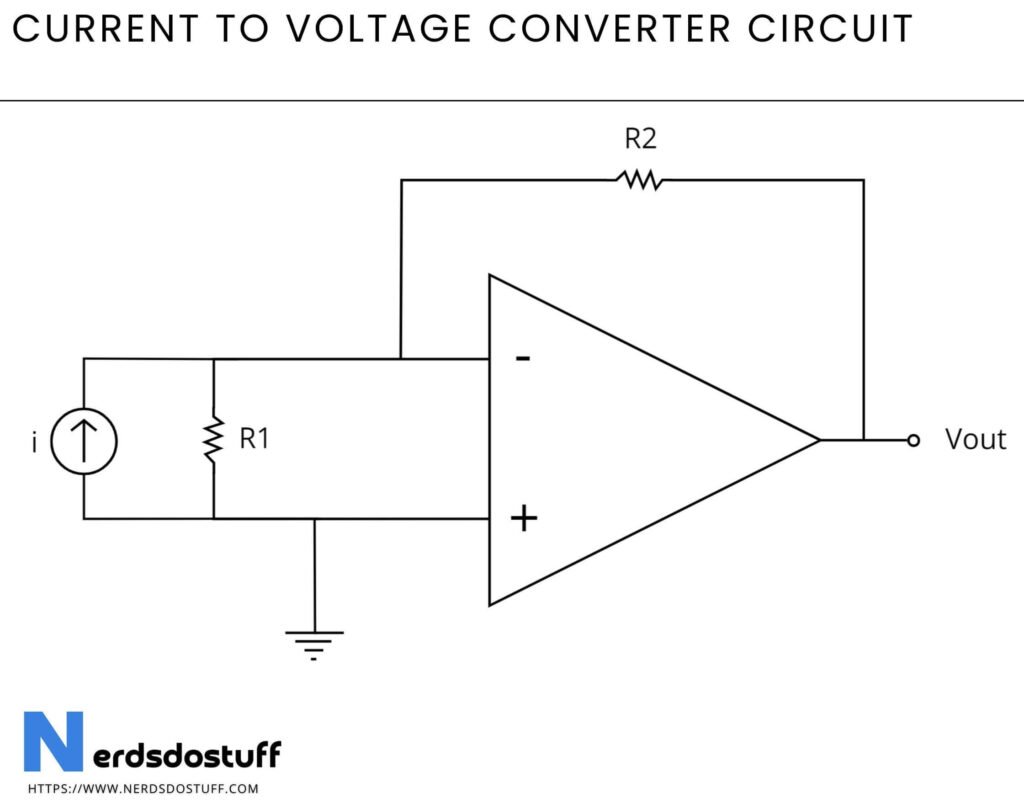What is Current to Voltage Converter ?
A current-to-voltage converter, also known as a transimpedance amplifier, is an electronic device that transforms an input current into a proportional output voltage. This conversion is essential in various applications, such as in photodetectors, where the device converts the small current generated by light into a readable voltage signal. The basic principle involves using an operational amplifier (op-amp) with a feedback resistor. The input current flows through this resistor, generating a voltage according to Ohm’s Law (V = IR). The op-amp maintains a virtual ground at its inverting input, ensuring that the current through the feedback resistor is equal to the input current, thus producing a corresponding output voltage.
Current to Voltage Converter Circuit

Working of Current to Voltage Converter
A current to voltage converter, also known as a transimpedance amplifier, typically operates using an operational amplifier (op-amp) and a feedback resistor. The current signal is fed into the inverting input of the op-amp, while the non-inverting input is connected to ground. The feedback resistor is connected between the output and the inverting input of the op-amp. As the input current flows through the feedback resistor, it creates a voltage drop across the resistor. The op-amp adjusts its output voltage to ensure that its inverting input is at the same potential as the non-inverting input (ground). This results in an output voltage that is directly proportional to the input current, with the proportionality factor being the value of the feedback resistor.
The primary function of the op-amp in this configuration is to maintain the virtual ground at the inverting input, ensuring that all of the input current flows through the feedback resistor. This provides a linear conversion from current to voltage, making the output voltage a precise representation of the input current.
Applications of Current to Voltage Converter
- Photodiode Amplifiers: Photodiodes generate a current proportional to the intensity of incident light. I-V converters are used to convert this small current into a corresponding voltage signal, which can then be easily measured and processed by electronic circuits, making them essential in optical sensors and communication systems.
- Current Sensing in Power Management: In power management and battery monitoring systems, it is crucial to measure the current flowing through a circuit accurately. I-V converters are used to convert the sensed current into a voltage signal that can be monitored and analyzed by control systems to ensure proper power distribution and battery health.
- Biomedical Instrumentation: In medical devices such as electrocardiograms (ECGs) and electroencephalograms (EEGs), small biocurrents are generated by the body. I-V converters amplify these currents into measurable voltage signals, enabling accurate monitoring and diagnosis of physiological conditions.
- Transimpedance Amplifiers in Test Equipment: Test and measurement equipment often requires precise conversion of current signals from sensors or probes into voltage signals for analysis. I-V converters are integral in these instruments, providing the necessary signal conditioning for accurate readings and data acquisition.
- Capacitive and Inductive Sensors: Capacitive and inductive sensors often produce current outputs that need to be converted to voltage for further processing. I-V converters are used to translate these current signals into usable voltage signals, enabling accurate measurement of parameters such as displacement, pressure, and fluid levels.
- Telecommunications: In telecommunications, particularly in fiber optic communication systems, photodetectors are used to convert light signals into electrical currents. I-V converters then transform these currents into voltage signals that can be further processed by electronic circuits for data transmission and reception.




